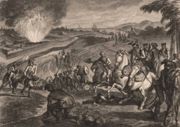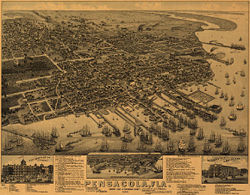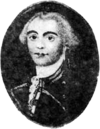Difference between revisions of "Portal:History"
(Historic Street Names in Pensacola -- Alcaniz Street.) |
(Can probably get rid of this...) |
||
| (2 intermediate revisions by the same user not shown) | |||
| Line 1: | Line 1: | ||
| + | <!-- This portal was created using subst:box portal skeleton --> | ||
| + | {{browsebar}} | ||
| − | + | <div style="width:100%"> | |
| − | + | {{/box-header|<big>The {{PAGENAME}} Portal</big>|{{FULLPAGENAME}}/Intro|}} | |
| + | {{{{FULLPAGENAME}}/Intro}} | ||
| + | {{/box-footer|}} | ||
| − | + | </div> | |
| + | <!-- use for randomized selected content rotation (also delete {{Purgepage}} at bottom of page) | ||
| + | <div style="text-align:center; margin:-7px; padding-bottom:12px;">{{purge|'''Show new selections'''}}</div> --> | ||
| + | <div style="float:left; width:60%;"> <!-- This width added to the the margin below to equal 99%--> | ||
| − | + | {{/box-header|Selected article|{{FULLPAGENAME}}/Selected article|}} | |
| + | {{{{FULLPAGENAME}}/Selected article}} | ||
| + | {{/box-footer|}} | ||
| + | {{/box-header|Selected picture|{{FULLPAGENAME}}/Selected picture|}} | ||
| + | {{{{FULLPAGENAME}}/Selected picture}} | ||
| + | {{/box-footer|}} | ||
| + | {{/box-header|Selected biography|{{FULLPAGENAME}}/Selected biography|}} | ||
| + | {{{{FULLPAGENAME}}/Selected biography}} | ||
| + | {{/box-footer|}} | ||
| − | + | </div> | |
| − | + | <div style="float:right; width:39%"> <!-- This margin should be right of the above --> | |
| − | + | {{/box-header|Categories|{{FULLPAGENAME}}/Categories|}} | |
| + | {{{{FULLPAGENAME}}/Categories}} | ||
| + | {{/box-footer|}} | ||
| − | + | </div> | |
| − | + | {{Purgepage}} | |
| − | + | __NOTOC__ __NOEDITSECTION__ | |
| − | |||
| − | |||
| − | |||
| − | |||
Latest revision as of 04:00, 2 July 2009
Business · Community · Culture · Geography · Government · History · Media · People · All Portals
The History Portal
Welcome to the History Portal. Here you will find links to the categories and articles that explore Pensacola's rich history.
Pensacola is known as America's First Settlement for an ephemeral colony led by Tristán de Luna y Arellano in 1559, which was wiped out by a hurricane. Previous Native American inhabitants date back to the Deptford civilization of around 50 BCE. Pensacola was resettled in 1698 and at various times has been under the possession of Spain, France, Britain, the Confederacy and the United States, earning the nickname the City of Five Flags.
Selected article
The Siege of Pensacola (also called the Battle of Pensacola) marked the culmination of Spain's conquest of Florida from Great Britain during the Revolutionary War in 1781. Spanish troops under Bernardo de Gálvez began an amphibious assault on the city in March 1781, steadily advancing towards Fort George on Gage Hill. On the morning of May 8, artillery fire sparked a fire within the Queen's Redoubt that detonated the powder magazine, allowing Spanish troops to capture the redoubt. British Governor Peter Chester and Major General John Campbell surrendered Fort George and Pensacola shortly thereafter.
Selected picture
The Wellge map is an aerial rendering of Pensacola created in 1885 by Henry Wellge. The extremely detailed lithograph is a bird's eye perspective of downtown Pensacola, then a bustling port city.
Selected biography
Elias Durnford (1739-1794) was a British military officer and civil engineer who is best known, in regard to Pensacola history, for surveying the town and laying out a city plan around two public squares (now Plaza Ferdinand VII and Seville Square). Durnford laid out the plan in 1764, shortly after the British took control of West Florida. He was also commanding British officer Fort Charlotte in Mobile when it surrendered to Gálvez on March 13, 1780.
Categories



